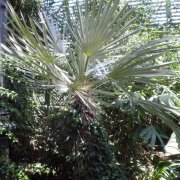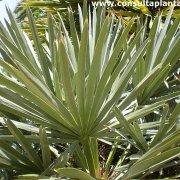Care of the palm tree Trithrinax campestris or Caranday palm |
|
The genus Trithrinax, family Arecaceae, includes 4 species of palm trees native to South America. The species are: Trithrinax campestris, Trithrinax brasiliensis, Trithrinax schizophylla, Trithrinax acanthocoma. Common names: Caranday palm, Blue Needle Palm. This species is native to Uruguay and Argentina. They are palm trees of medium size that reach 6 meters (19.68 feet) in height. They have palmate, rigid and green or bluish leaves. The leaves tend to stick to the trunk when they dry to protect the plant from the cold. The flowers are small, white or cream in color and appear in branched inflorescences. They bloom in autumn. To obtain seeds you have to wait until the following summer to collect the fruits. This slow-growing, low-maintenance plant is used in small groups and as isolated specimens. Caranday palm is ideal for dry areas of the garden and for rockeries. The leaves are used to make hats and other crafts. Trithrinax campestris can grow in full sun or semi-shade exposures. It resists hot and icy temperatures down to -10 ºC (14 ºF). Caranday palm grows in any well-drained soil: poor, sandy, stony, saline or calcareous. Blue Needle Palm has high resistance to drought; water moderately waiting for the soil to dry out. Trithrinax campestris does not need fertilizers or pruning. Blue Needle Palm is a palm tree resistant to the usual pests and diseases. Caranday palm is propagated from seeds sown in spring in a sandy substrate; they can take up to 6 months to germinate. |
Images of the palm tree Trithrinax campestris or Caranday palm |
Find plants
Trithrinax campestris or Caranday palm | Care and Growing
© 2026 FavThemes







